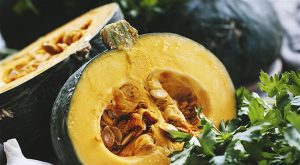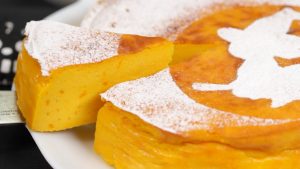Kabocha (/kəˈboʊtʃə/; from Japanese カボチャ, 南瓜) is a type of winter squash, a Japanese variety of the species Cucurbita maxima. It is also called kabocha squash in North America. In Japan, “kabocha” may refer to either this squash or to the Western pumpkin. It has a strong yet sweet flavor and moist, fluffy texture like chestnuts.
Cucurbita maxima. It is also called kabocha squash in North America. In Japan, “kabocha” may refer to either this squash or to the Western pumpkin. It has a strong yet sweet flavor and moist, fluffy texture like chestnuts.
Many of the kabocha in the market are kuri kabocha, a type created from seiyo kabocha (buttercup squash). Varieties of kabocha include Ajihei, Ajihei No. 107, Ajihei No. 331, Ajihei No. 335, Cutie, Ebisu, Emiguri, and Miyako.
Kabocha is hard on the outside with knobbly-looking skin. It is shaped like a squat pumpkin and has a dull-finished, deep-green skin with some celadon-to-white stripes and an intense yellow-orange color on the inside. In many respects it is similar to buttercup squash, but without the characteristic protruding “cup” on the blossom (bottom) end. An average kabocha weighs 2-3 pounds, but a large specimen can weigh as much as 8 pounds.
Kabocha has an exceptional sweet flavor, even sweeter than butternut squash. It is similar in texture and flavor to a pumpkin and sweet potato combined. Some kabocha can taste like Russet potatoes. The rind is edible although some cooks may peel it to speed up the cooking process or to suit their personal taste preferences. Kabocha is commonly utilized in side dishes and soups, or as a substitute for potato or other squash varieties. It can be roasted after cutting the squash in half, scooping out the inside rind and seeds, and then cutting the squash into wedges. A little olive oil and seasoning and it can be baked in the oven.
 In Japan, kabocha is a common ingredient in vegetable tempura and is also made into soup. Fak thong (Thai: ฟักทอง) is used in traditional Thai desserts and main courses. Kabocha is used in Jamaican chicken foot soup. Danhobak (Korean: 단호박) is commonly used for a traditional Korean porridge called hobakjuk (호박죽), which is mainly eaten during autumn and winter. Hobakjuk in the west is more likely to contain pumpkin than kabocha. Shown on the right, kabocha is a common ingredient in tempura
In Japan, kabocha is a common ingredient in vegetable tempura and is also made into soup. Fak thong (Thai: ฟักทอง) is used in traditional Thai desserts and main courses. Kabocha is used in Jamaican chicken foot soup. Danhobak (Korean: 단호박) is commonly used for a traditional Korean porridge called hobakjuk (호박죽), which is mainly eaten during autumn and winter. Hobakjuk in the west is more likely to contain pumpkin than kabocha. Shown on the right, kabocha is a common ingredient in tempura
Kabocha is available all year but is best in late summer and early fall. Kabocha is primarily grown in Japan, South Korea, Thailand, California, Florida, Hawaii, Southwestern Colorado, Mexico, Tasmania, Tonga, New Zealand, Chile, Jamaica, and South Africa, but is widely adapted for climates that provide a growing season of 100 days or more. Most of the kabocha grown in California, Colorado, Tonga and New Zealand is actually exported to Japan.